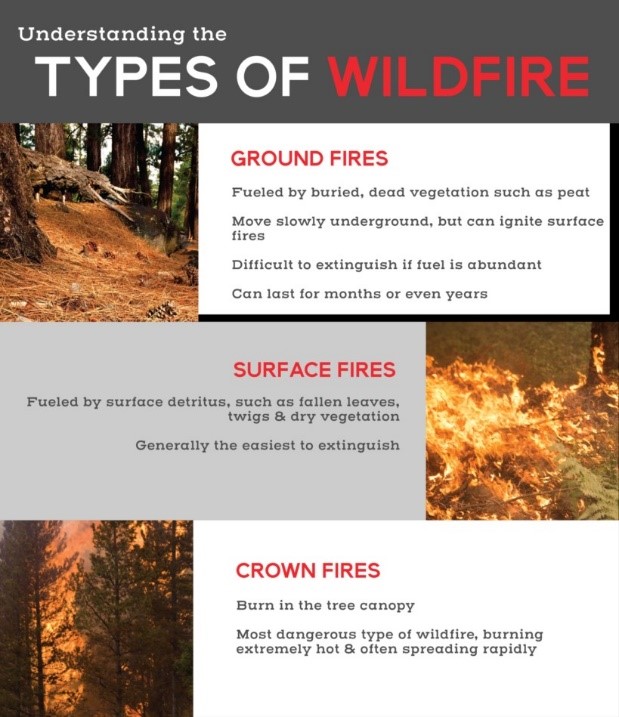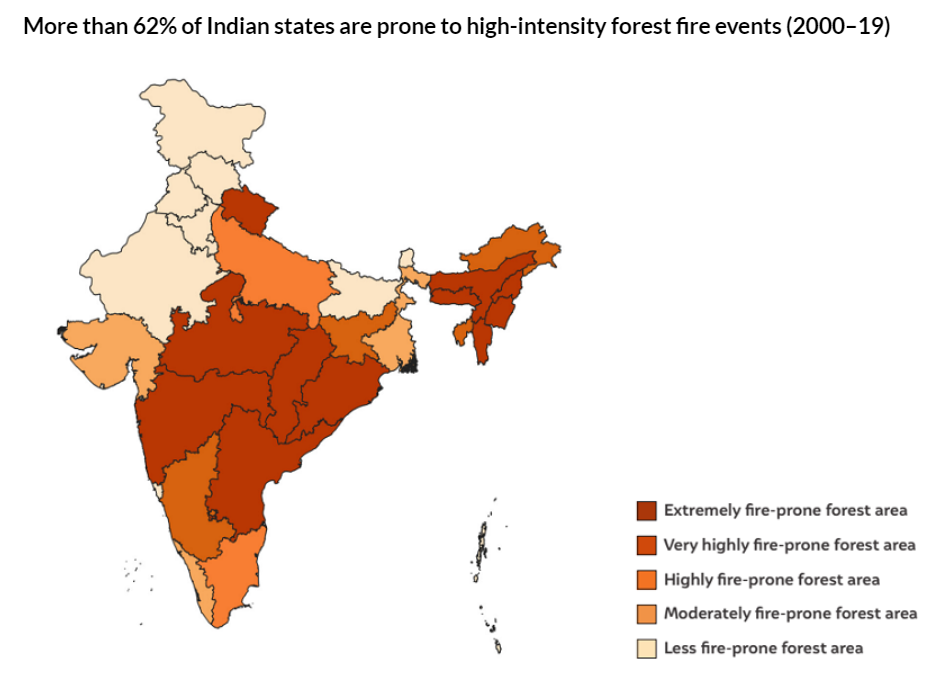Biodiversity & Environment
Forest Fires in Goa
- 10 May 2023
- 7 min read
For Prelims: Forest Fires: Types, Causes, advantages and disadvantages, National Action Plan for Forest Fires (NAPFF), National Afforestation Programme (NAP)
For Mains: Forest Fires and its mitigation
Why in News?
The inquiry of bushfires that broke down in March 2023 by Goa Forest department has found that the fires were largely triggered by natural causes.
What did the Forest Department Inquiry Find?
- Cause behind Forest Fire: The report suggests that a conducive environment and extreme weather conditions — deficient rainfall in the preceding season, unusually high temperatures, low moisture and humidity — led to the fires.
- Very little rain in Goa since October 2022, along with heat-wave-like conditions and low humidity, created conditions that were ripe for forest fires.
- Goa's Forest Fire:
- The India State of Forest Report (ISFR) 2021 published by the Forest Survey of India (FSI) classifies 100% of Goa’s forest cover as “less fire prone”.
- Also, Goa does not experience crown fires (caused by friction of trees) which mostly occur abroad.
- Surface fires are common in moist deciduous forests of Goa.
- Minor surface fires that burn undergrowth and dead organic matter on the forest floor are common due to the slash-and-burn techniques used by villagers to clear grazing land for cattle.
- Cashew farmers often start minor constrained fires to clear weeds and reduce undergrowth.
What are Forest Fires?
- About:
- Forest fires are uncontrolled fires that occur in areas with a significant amount of combustible vegetation, such as forests, grasslands, or shrublands.
- Causes of Forest Fire:
- Natural: Lightning is the most prominent cause which set trees on fire. However, rain extinguishes such fires without causing much damage.
- Spontaneous combustion of dry vegetation and volcanic activities also cause forest fires.
- High atmospheric temperatures and dryness (low humidity) offer favorable circumstance for a fire to start.
- Man-Made: Fire is caused when a source of fire like naked flame, cigarette or bidi, electric spark or any source of ignition encounters inflammable material.
- Natural: Lightning is the most prominent cause which set trees on fire. However, rain extinguishes such fires without causing much damage.
- Types:
- Crown fires burn trees up their entire length to the top. These are the most intense and dangerous wildland fires.
- Surface fires burn only surface litter and duff. These are the easiest fires to put out and cause the least damage to the forest.
- Ground fires (sometimes called underground/subsurface fires) occur in deep accumulations of humus, peat and similar dead vegetation that become dry enough to burn.
- Advantages:
- Cleaning the Forest Floor
- Providing Habitat
- Killing Disease
- Nutrient Recycling
- Disadvantages:
- Kill or Injure unintended Plants/Trees
- Can Lead to Erosion and Sedimentation
- Can Devastate the Ecosystem
- Threat to Human Life
- Vulnerability in India:
- The forest fire season normally extends from November to June in India.
- A report by the Council of Energy, Environment and Water (CEEW) has noted:
- A tenfold increase in forest fires over the past two decades and says more than 62% of Indian states are prone to high-intensity forest fires.
- Andhra Pradesh, Odisha, Maharashtra, Madhya Pradesh, Chhattisgarh, Uttarakhand, Telangana, and the Northeastern states are most prone to forest fires.
- Mizoram has seen the highest incidence of forest fires over the last two decades, and 95% of its districts are forest fire hotspots.
- The ISFR 2021 estimates that more than 36% of the country’s forest cover is prone to frequent forest fires, 6% is ‘very highly’ fire-prone, and almost 4% is ‘extremely’ prone.
- Also, An FSI study has found that nearly 10.66% area under forests in India is ‘extremely’ to ‘very highly’ fire prone.
What are the India’s Initiatives Related to Managing Forest Fires?
- National Action Plan for Forest Fires (NAPFF): It was started in 2018 with the goal of reducing forest fires by informing, enabling, and empowering forest fringe communities and incentivizing them to collaborate with state forest departments.
- National Mission for Green India (GIM): Launched under the National Action Plan on Climate Change, the GIM aims to increase forest cover and restore degraded forests.
- It promotes the use of community-based forest management, biodiversity conservation, and sustainable forest practices, which contribute to preventing forest fires.
- Forest Fire Prevention and Management Scheme (FFPM): FFPM is implemented by the FSI under the MoEF&CC. It aims to strengthen the forest fire management system by utilizing advanced technologies such as remote sensing.
- It is the only government-sponsored programme dedicated to assisting states in dealing with forest fires.
What should be done to Mitigate Forest Fires?
- Create Fire Breaks: Fire breaks are areas where vegetation has been removed, creating a gap that can slow or stop the spread of a fire.
- Monitor and Manage Forests: Monitoring forests and managing them appropriately can help prevent fires from starting or spreading.
- Early Detection and Rapid Response: Early detection of a forest fire is critical for effective mitigation.
- The Forest Survey of India (FSI) is using satellite imaging technology (like MODIS) to analyse forest fire affected areas and boost prevention.
- Fuel Management: Reducing the accumulation of dead trees, dry vegetation, and other combustible materials through activities such as thinning and selective logging.
- Firewise Practices: Safe practices must be adopted in areas near forests viz. factories, coal mines, oil stores, chemical plants and even in household kitchens.
- Practice Controlled Burning: Controlled burning involves setting small fires in a controlled environment.








